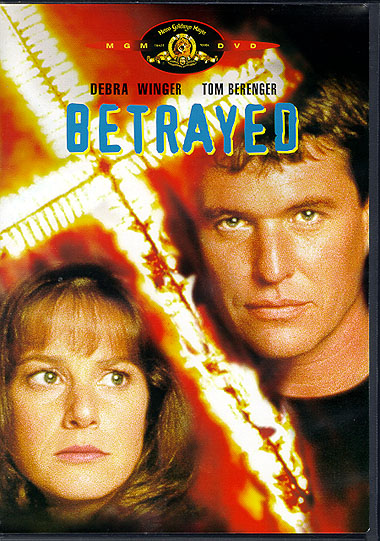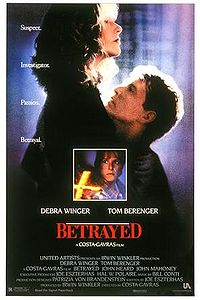From the September 2, 1988 Chicago Reader. — J.R.
BETRAYED
** (Worth seeing)
Directed by Costa-Gavras
Written by Joe Eszterhas
With Debra Winger, Tom Berenger, John Heard, John Mahoney, Ted Levine, Maria Valdez, Betsy Blair, and Richard Libertini.
Although I liked Betrayed enough to make it a Critic’s Choice last week, a second look has convinced me that it has a fair number of strikes against it. Joe Eszterhas’s script clearly plows more than it sows, and sows (in a rather scattershot fashion) more than it reaps. The dialogue tends to fall back on so many familiar notions about simple farmers and hard-nosed federal agents that if less talented actors than Debra Winger, Tom Berenger, John Heard, and John Mahoney were assigned the lines, I doubt that we could accept them even half-heartedly.
Costa-Gavras’s direction, moreover, is more competent than inspired; the film functions as a thriller, but only barely. What the movie has going for it, really, is a germ of an idea — but one that is potent enough to give this story a sharp and unsettling charge. That the movie deals with rabid American racism without hedging on either its ugliness or its intensity is itself an accomplishment of some note. Nowadays overt racism is a “safe” and respectable subject for commercial movies only if it’s kept at a comfortable distance by being situated in South Africa or in another century — anywhere, in fact, but here and now.
Even movies of the repressed 50s dealt with racism more courageously and frequently than those of the present have — albeit in terms that were usually couched in the liberalism of the social-problem film. The racists in The Blackboard Jungle, The Defiant Ones, 12 Angry Men, The Phenix City Story, Sayonara, Baby Doll, and Imitation of Life (among others) were conveniently characterized by their “otherness” — fall-guy villains or stooges who rarely threatened the essential, right-thinking goodness of the heroes. The most interesting treatments of racism in that period — Samuel Fuller’s The Steel Helmet, John Ford’s The Searchers, and Orson Welles’s Touch of Evil — complicated this simple polarity by giving us racist heroes or antiheroes who implicated the spectator in their own contradictions, although the emotional complications ensuing from this were never critically acknowledged at the time.
Conceptually speaking, Betrayed lies somewhere in between the social-problem film of the 50s and the more subtle and dangerous analyses of Fuller, Ford, and Welles. It gives us a right-thinking FBI agent, Cathy Weaver (Debra Winger), assigned to help solve the murder of a racist-baiting Chicago talk-show host (Richard Libertini). Under the name Katie Phillips, she infiltrates a suspected white supremacist group of midwestern farmers. Rather than keep us glued to this scenario throughout, the movie begins with the murder and then apparently switches course to show us Katie Phillips, a combine driver from Texas, meeting Gary Simmons (Tom Berenger), a Vietnam veteran and widower who lives on a farm with his mother and his two kids. Katie immediately falls for Gary’s family — in particular his little girl Rachel (Maria Valdez) — and gradually falls for Gary as well. Only after she meets Gary at work and then again at a local bar, gets invited to his house for supper, spends the Fourth of July with him and his family, and becomes romantically involved with him, do we discover that she is an agent named Cathy Weaver, formerly involved romantically with her FBI colleague (John Heard), to whom she reports her findings.
This already deviates from the 50s social-problem film in a couple of important respects. We’re allowed to become acquainted with Gary, his family, and his circle before we have much of an idea about his racism; we’re also allowed to become acquainted with Katie before we realize that she is a spy. From what we see of Gary, he seems a mite touchy and cranky, but none of this is allowed to interfere with what seems like a conventional setup for a conventional love story with a likable hero and heroine. (Debra Winger’s being Jewish, however, does fit the 50s formula of such movies as Gentleman’s Agreement, which featured Gregory Peck, a Jew, playing a gentile — in that case, to complicate matters, a gentile pretending to be a Jew.)
Radio talk-show host Sam Kraus, whom we see during the opening credits insulting and sparring with call-in listeners, and who is then gunned down shortly after leaving the studio, is made to seem every bit as repugnant as the racist villains in the 50s social-problem films; as played by Richard Libertini, he comes across as anything but a typical liberal martyr. Calling himself “Jewboy,” he jeeringly invites the “kike haters” to phone in, glibly insults lesbians and born-again Christians, taunts and humiliates a woman caller about being overweight, and in general acquits himself as obnoxiously as any anti-Semite could desire.
Costa-Gavras alternates shots of Kraus spouting his hate-filled diatribes in the studio with shots of blank, faceless skyscrapers; the fat woman who phones in is glimpsed from a distant balcony, but the other callers — including a woman who insists that the Holocaust was an “exaggeration” — remain unseen, and the assassin preparing to shoot Kraus is glimpsed only elliptically. All of these elements create a sense of paranoia and conspiracy that later portions of the film will build upon — not always well or wisely — but the apparent irrelevance of this opening to the budding love story that immediately follows is essential to the film’s overall strategy of disturbing us. Moving directly from sharp, abrasive urban divisions in the prologue to warmer social and communal gatherings in the country, we’re encouraged not to dwell on any interdependence or similarity of these two realms, though the film broaches them later.
Consequently, once the FBI enters the picture, we can’t simply and unequivocally get behind Cathy Weaver’s colleagues as the forces of good. Their mission is to bust a white supremacist conspiracy by nailing an assassin, which we certainly endorse, but their own vindictiveness and snappy aggression carry some echoes of the malice of Kraus. By the time that Cathy comes face-to-face with the rampant racism of Gary and his people, which the film contrives to make as shocking as possible, we can’t take sides without feeling some undertow of conflict about our position. Cathy/Katie, at the center of this conflict, remains our identification figure, and her sexual preference for Gary, over her FBI colleague David, as well as her qualms about spying on her lover, become emblematic of the moral ambiguities involved.
Part of the value of this ambiguity is that it attacks the compartmentalized ways we have of dealing with (or thinking about) prejudice — the naive belief that it can simply be isolated, contained, and thereby eradicated like bacteria. On one level, the film goes along with this belief by offering us an FBI that is supposedly free of prejudice (an astonishing notion and quite the reverse of the FBI that functioned under J. Edgar Hoover during the civil rights movement) in combat with lunatic racists who hunt down blacks in cold blood, teach their children that Jews are lice-ridden perverts, and dream of shooting down homosexuals in the streets. Yet on another level, the FBI and the supremacists are shown to be surprisingly similar in their isolation, their ruthlessness, and their blind hatred for their opponents — indeed, in their exclusive claims of humanity. (The increasing division of this country into autonomous special-interest groups separated by class, politics, race, and ethnicity has rarely been addressed in movies, which generally prefer to exploit such divisions in their marketing rather than to draw attention to them, and in a way this movie’s handling of this theme is even more striking than its handling of prejudice per se.)
This second level comprises the germ of the idea that makes Betrayed both provocative and unnerving. It simultaneously portrays Kraus and the FBI as rather grubby and humanizes the racists (without ever endorsing any aspect of their racism). Unfortunately, the only antidote to this vision it can offer is Cathy as a goddess of maternal love who ultimately rejects the FBI as well as the white supremacists so that she might someday teach love and understanding to Gary’s daughter Rachel. It’s a 50s solution that won’t wash, not even with a gooey freeze-frame to drive it home, because it represents a calculated retreat from the message that isolation and alienation themselves create the attitudes that inform both enemy camps. Isolation and alienation are all that Cathy winds up with, and for the film to sentimentalize this is to arrive at a tautological stalemate.
Some of the particulars of the film’s handling of the lunatic right seem needlessly farfetched — which is not to say that they don’t necessarily have real-life counterparts, only that the film fails to flesh them out persuasively — but the overall drift is chillingly plausible, at least for someone like myself who grew up in the deep south and who assumes that rabid xenophobia is still operative in this country regardless of how little the media choose to focus on it. It’s easy to fault Costa-Gavras and Joe Eszterhas for not fully realizing either the execution or the implications of their corrosive scenario; but their tackling it at all is reason for some gratitude.


